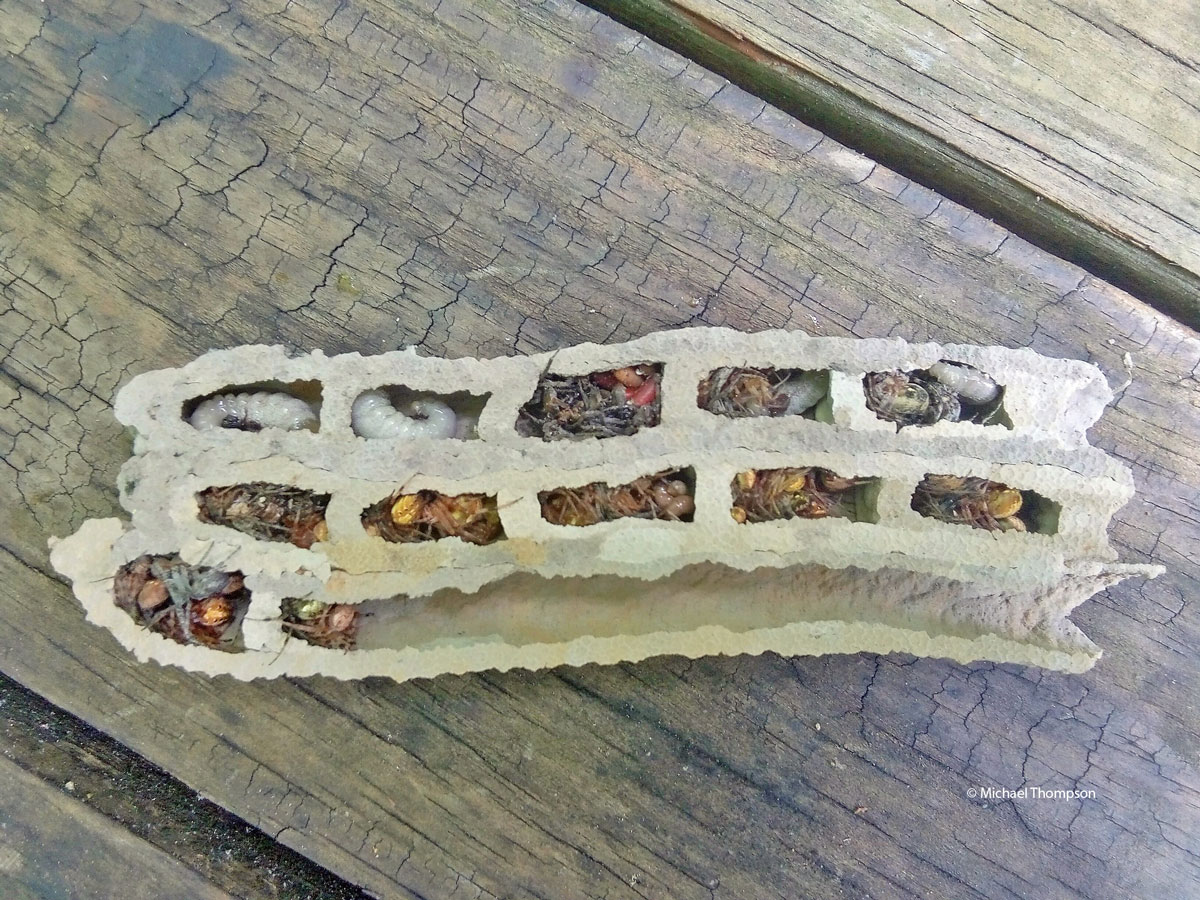Organ Pipe Mud Dauber, Vol. 6, No. 20

Organ Pipe Mud Dauber
Trypoxylon politum
Order: Hymenoptera
Family: Crabronidae
If you build your home out of mud, it is wise to build where it is protected from rainfall. In nature, mud daubers build their nests in protected areas such as caves, rock overhangs, hollow trees, and the undersides of large tree limbs. Of course, they also build nests in our garages, attics, and patios, as well as in covered areas of automobiles, boats, and other equipment. Mud dauber nests are unsightly, and the mud can stain walls and ceilings. Even worse, a mud dauber nest built in the wrong place on an infrequently used machine can cause a lot of mechanical damage when that machine is used.
The nests of organ pipe mud daubers are easy to distinguish from the nests of black and yellow mud daubers. Organ pipe mud dauber nests are mud tubes up to six or more inches long and are oriented vertically. Black and yellow mud dauber nests are blockier in shape, only a couple of inches long, and usually oriented horizontally. Both species fill the cells of their nests with spiders they capture using a precisely placed, paralyzing sting. A single egg is deposited in each cell before it is sealed, and the developing larva dines on spiders until large enough to pupate. Once mature, the young wasp exits the nest by cutting a hole through the side.
These two mud daubers hunt different types of spiders. Organ pipe mud daubers focus primarily on mid-sized orb weaver spiders, such as Hentz orb weavers. When they are not hauling mud and building their nests, females are busy hunting spiders. The males’ job is to guard the nest. There are other species of wasps that specialize in parasitizing mud daubers. One of these is a small, metallic green wasp known as a cuckoo wasp. There are also tiny, gnat-sized wasps, Melittobia spp., that lurk around the entrance waiting a chance to dart in and lay their eggs. Males must also guard against rival males and other females that might try to steal spiders or take over the nest. Observe a nest that is under construction and you will probably see the male resting just inside the entrance. You may even notice one or more of the parasitic wasps waiting nearby.
Can mud daubers sting? Yes, and stings are painful, but like most solitary wasps, mud daubers are not aggressive and do not defend their nest. Consequently, stings are rare and only occur when a female is trapped against the skin in some way.
Control: Unfortunately, there is no simple, once-and-done, control for mud daubers. The best way to limit the number of nests in your garage or porch is to kill nesting females as soon as they appear. You can use a fly swatter to apply mechanical control or spray them, or the entrance of their nest, with a can of wasp spray. But be aware that some sprays contain petroleum products that can stain walls. Some aerosol insecticides come with a special straw that makes it easy to spray into the nest entrance without getting much spray on walls and ceilings. Remove existing nests by scraping them off and using a wet cloth and a spray bottle filled with water to remove the remaining mud. Good physical exclusion is the best means of preventing mud dauber nests in attics and mechanical equipment.
Blake Layton, Extension Entomology Specialist, Mississippi State University Extension Service.
The information given here is for educational purposes only. Always read and follow current label directions. Specific commercial products are mentioned as examples only and reference to specific products or trade names is made with the understanding that no discrimination is intended to other products that may also be suitable and appropriately labeled.
Mississippi State University is an equal opportunity institution.

